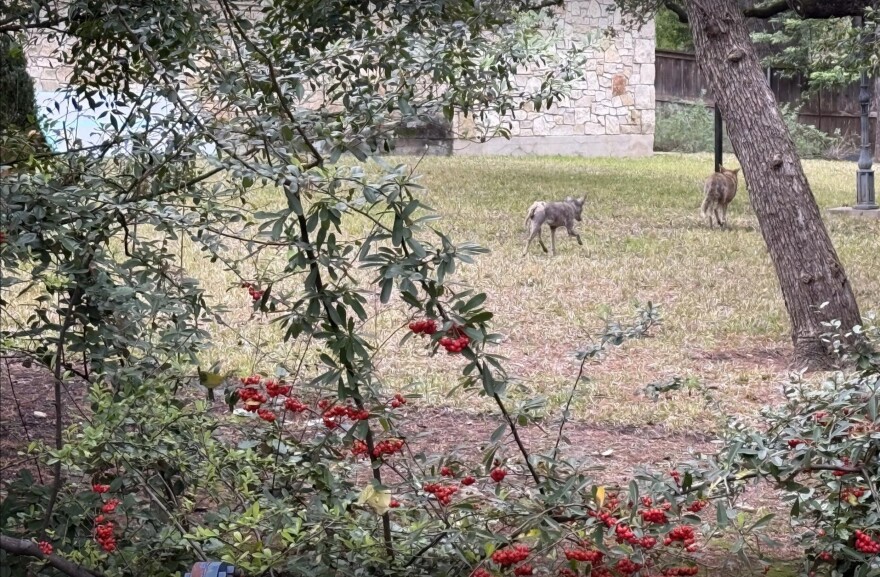Coyote mating season is hitting its peak this week, which means there’s a chance you’ll be hearing and seeing more of them.
The season begins in January, peaks in late February, and ends in early March. During this time it's common to hear more coyotes howling and spot them as they find their mates, claim their territory and settle in their dens, according to the nonprofit Project Coyote.
So whether or not you like them in your backyard, H-E-B parking lot or elsewhere, you’ll have to learn to coexist with them.
Coyotes are smart and adaptable. When their populations are threatened, they respond by reproducing more and birthing larger litters. So despite attempts to eradicate coyotes, these mammals that are native to North America are still roaming around the Central Texas region in healthy numbers. Emery Sadkin, a City of Austin wildlife officer, said today coyotes can be found in every single Austin neighborhood.
“[They’re] pretty much everywhere,” she said. “They’re very used to all the people and all the sounds.”
What should you do if you spot a coyote?
If you see a coyote, don't panic.
Sadkin said there are occasional reports of coyotes chasing people in Austin, but it’s usually the person who starts running first.
“It’s like a dog, if you run away from a dog, the dog is going to chase after you,” Sadkin said. “It’s just in their instinct.”
Although you might get chased or followed home by a coyote, Sadkin said she’s never received a report of one making contact with a human. People shouldn’t be concerned about coyotes around children, either, she added.
“If your child is allowed to be outside unsupervised, then they are old enough to be educated about coyotes and wildlife. I go to career days, I start as young as first graders, teaching them about coyotes and wildlife and they all understand it,” she said.
Texas Parks and Wildlife advises against feeding coyotes because it can lead to aggression toward people. To avoid accidentally feeding them, keep pet food inside, clean up any bird seed that falls, and make sure your trash is secured.
Coyotes are most active during dawn or dusk, and if you spot one then, you don’t need to react. But if you happen to see one sauntering around the neighborhood in the middle of the day, Sadkin recommends taking steps to reinforce its fear of humans.
“If it’s out in the middle of the day and you see a coyote laying in someone’s yard, force that coyote to get up. Yelling at them, throwing things at them, charging at them, anything that forces them to get up. Because if you allow that coyote to lay there and watch you walk by, that’s a positive interaction and the coyote now thinks, ‘Okay I can start laying here and everything is going to be fine,’” she said.
Do coyotes eat pets?
Coyotes with mange — a skin disease caused by eating rats that have ingested rat poisoning — are more likely to be seen out during the day compared to healthy coyotes. Mange disrupts a coyote's ability to regulate their own body temperature, so they can often be seen sunbathing in people’s front yards to stay warm.
“It’s super, super common here in Austin,” Sadkin said. “People think because it has mange it's more prone to go after a person, but in reality the mange makes them incredibly weak, so they are going after super easy food sources.”

One of those easy food sources, Sadkin said, is outdoor cats. Coyotes are opportunistic eaters that go after what’s local and seasonally available. Most of the time that means rodents, insects, grass and berries. But if necessary, they will eat small pets.
Sadkin recommends always keeping an eye on your pet and investing in a coyote vest — a colorful, spiky garb that can protect small dogs and cats from coyotes and other predators.
The City of Austin doesn't trap and treat coyotes with mange because there are so many of them, but if a coyote is especially aggressive, you can call 311.
If you miss seeing a coyote this month, you might have a better chance come October. That’s when all the coyote pups born in the spring are pushed out of their dens, Sadkin said.
“That means they are roaming the streets, they’re in the neighborhoods, and they are trying to find their own territory and their own space now,” she said.









